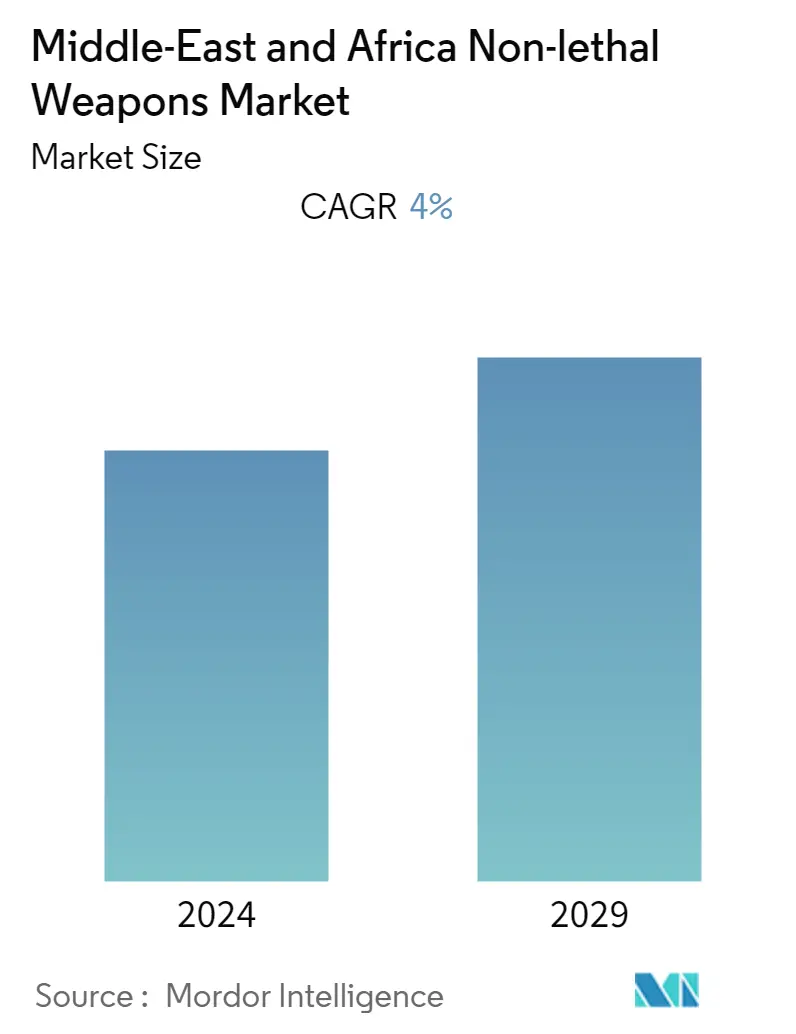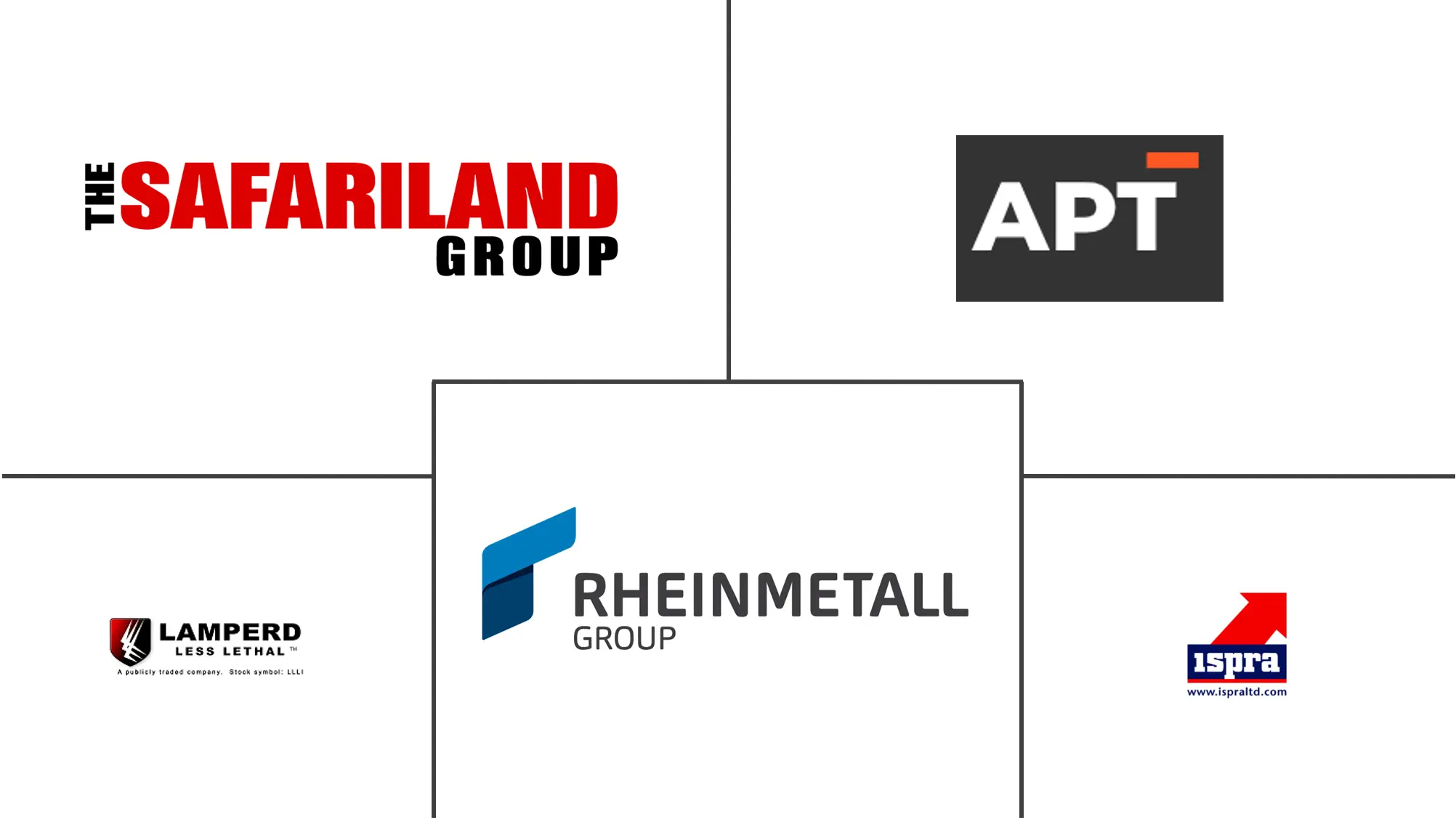Market Size of Middle-East and Africa Non-lethal Weapons Industry

| Study Period | 2020 - 2029 |
| Base Year For Estimation | 2023 |
| Forecast Data Period | 2024 - 2029 |
| Historical Data Period | 2020 - 2022 |
| CAGR | 4.00 % |
| Market Concentration | High |
Major Players
*Disclaimer: Major Players sorted in no particular order |
Middle-East And Africa Non-lethal Weapons Market Analysis
The Middle East and African non-lethal weapon is expected to register a CAGR of 4.34% during the forecast period
- The onset of the COVID-19 pandemic led to various countries implementing border restrictions as well as lockdowns which led to restrictions in terms of the supply of the components which are used to make the less lethal weapons. During the COVID-19 pandemic, manufacturing witnessed a steep decline due to supply chain disruption. Post the lockdown, however, the demand has surged on account of the ongoing political turmoil in some countries like Lebanon, South Africa, Zimbabwe, Tunisia, and Libya, leading to situations similar to an insurgency.
- The increasing dissatisfaction with the local governments in these countries is leading to an increase in major violence and riots, necessitating law enforcement agencies to utilize non-lethal methods for crowd management. This has led to an increase in orders to procure new non-lethal weapons to effectively tackle a dangerous situation.
- With the presence of very few players in non-lethal weapons manufacturers in this region, there is a profitable scenario for new companies to enter the Middle East and Africa non-lethal weapons market. However, the low GDPs of the African countries and recurring investments required to evolve a non-lethal weapon in compliance with developing industry norms may hamper the growth of the market.
Middle-East And Africa Non-lethal Weapons Industry Segmentation
Non-lethal weapons are defined as all the weapons that can cause pain/irritation on contact either to the skin or any of the human senses, without any permanent damage to any of the senses or bodily functions of the victim.
The Middle East and Africa's non-lethal weapons market have been segmented by type, end-user, and country. By type, the market has been segmented into ammunition, explosives, gases and sprays, and other types. By end user, the market has been segmented into law enforcement and the military. By geography, the market has been segmented into Saudi Arabia, South Africa, United Arab Emirates, Qatar, and the Rest of the Middle East and Africa.
The report offers market size and forecast in terms of value (USD Million) for all the above segments.
| Type | |
| Ammunition | |
| Explosives | |
| Gases and Sprays | |
| Other Types |
| End User | |
| Law Enforcement | |
| Military |
| Geography | |
| Saudi Arabia | |
| South Africa | |
| United Arab Emirates | |
| Qatar | |
| Rest of Middle-East and Africa |
Middle-East and Africa Non-lethal Weapons Market Size Summary
The Middle East and Africa non-lethal weapons market is poised for growth, driven by increasing political unrest and the need for law enforcement agencies to manage civil disturbances without resorting to lethal force. The market is characterized by a limited number of manufacturers, creating opportunities for new entrants. The demand for non-lethal weapons has surged post-COVID-19 lockdowns, particularly in countries experiencing political turmoil, such as Lebanon, South Africa, and Zimbabwe. These regions have seen a rise in protests and riots, prompting law enforcement to procure advanced non-lethal solutions like tasers, batons, and chemical agents to maintain order. Despite the challenges posed by low GDPs in some African countries and the need for ongoing investment in compliance with industry standards, the market is expected to expand steadily.
In South Africa, the high frequency of public protests has led to increased defense spending on non-lethal weapons, such as tear gas and water cannons, to manage civil unrest effectively. The country's status as a protest capital has driven law enforcement agencies to enhance their capabilities with advanced non-lethal technologies. The presence of key players like Safariland, LLC, and Rheinmetall AG, along with local collaborations, supports market growth. Additionally, innovations such as Israel's robotic weapons and the Skunk malodorant for crowd control highlight the ongoing advancements in non-lethal weaponry. These developments, coupled with government grants and strategic procurements, are expected to positively influence the market's trajectory over the forecast period.
Middle-East and Africa Non-lethal Weapons Market Size - Table of Contents
-
1. Market Dynamics
-
1.1 Market Overview
-
1.2 Market Drivers
-
1.3 Market Restraints
-
1.4 Industry Attractiveness - Porter's Five Forces Analysis
-
1.4.1 Threat of New Entrants
-
1.4.2 Bargaining Power of Buyers/Consumers
-
1.4.3 Bargaining Power of Suppliers
-
1.4.4 Threat of Substitute Products
-
1.4.5 Intensity of Competitive Rivalry
-
-
-
2. Market Segmentation
-
2.1 Type
-
2.1.1 Ammunition
-
2.1.2 Explosives
-
2.1.3 Gases and Sprays
-
2.1.4 Other Types
-
-
2.2 End User
-
2.2.1 Law Enforcement
-
2.2.2 Military
-
-
2.3 Geography
-
2.3.1 Saudi Arabia
-
2.3.2 South Africa
-
2.3.3 United Arab Emirates
-
2.3.4 Qatar
-
2.3.5 Rest of Middle-East and Africa
-
-
Middle-East and Africa Non-lethal Weapons Market Size FAQs
What is the current Middle-East and Africa Non-lethal Weapons Market size?
The Middle-East and Africa Non-lethal Weapons Market is projected to register a CAGR of 4% during the forecast period (2024-2029)
Who are the key players in Middle-East and Africa Non-lethal Weapons Market?
Safariland, LLC, Rheinmetall AG, Advanced Pyrotechnics LLC, ISPRA by EI Ltd. and Lamperd Less Lethal are the major companies operating in the Middle-East and Africa Non-lethal Weapons Market.

